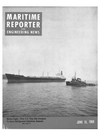
Page 38: of Maritime Reporter Magazine (June 15, 1969)
Read this page in Pdf, Flash or Html5 edition of June 15, 1969 Maritime Reporter Magazine
An Advance In Navigation Technology The Newly Developed Litton Marine Navigator Can Be A Valuable Aid In Marine Exploration By Providing Precision Navigation Warren A. Wanamaker and Dr. Jerome S. Lipman* The existence of important requirements and critical problems of marine exploration has led to the development of a fully-auto-mated, self-contained, all-weather system that provides continuous real-time precision navi-gation throughout the world. The new system was made possible by recent advances in navi-gation technology. Known as the Litton Marine Navigator (LMN), it integrates a sonar-doppler velocity sensor and navigation satellite receiver with an inertial navigation system. The inertial navigation system, with its as-sociated general-purpose computer, is the nu-cleus of the LMN. Its continuous operation over the total dynamic range of vehicle kine-matics (independent of all environmental and operational characteristics) ensures the avail-ability of timely and accurate data, free from interruption and loss of information. It pro-vides the required multiple-angle resolution and filtering of the sonar-doppler velocity, thus ensuring its fidelity over the spectrum of vehi-cle dynamics and minimizing the effects of spurious doppler noise. The sonar-doppler velocity information is introduced into the inertial system in a fashion commonly referred to as either a "damped in-ertial mode" or a "continuous gyrocompass mode." The desired degree of damping is a function of the characteristics of the operating environment and is automatically selected by the system. The way in which the system is integrated yields velocity accuracies bounded only by the limitations of sonar-doppler ac-curacy (more accurate than a ship's log) and inertial platform heading accuracy (more ac-curate than a gyrocompass). The long-term position accuracy of the LMN is automatically obtained from periodic posi-tion resets from the U.S. Navy Navigation Satellite System, which is now available for commercial use. The uninterrupted precision velocity information from the sonar-doppler-augmented inertial system essentially removes errors (caused by the inaccuracy of the user's knowledge of his own velocity) from the posi-tion fix by the navigation satellite. The LMN system includes the required data channels and controls for incorporating a multi-channel digital recorder to provide a rec-ord of all generated velocity, position, attitude, and sensed information. The digital recorder is an optional unit that can be furnished by the user if desired. An X-Y plotter and paper tape printer are part of the basic system. The requirements for system power are met with input of 115-volt, 60-cycle, 3-phase pow-er. In addition, the unit contains batteries that ensure continuous operation of the inertial navigation system during an interruption of the primary power source. An inertial navigation system, consisting of an inertial measurement unit and a general-purpose computer, is capable of performing the total navigation function by itself. However, because its errors are not totally position- or *Mr. Wanamaker, manager of Navy and Marine programs marketing, and Dr. Lipman, office of the chief scientist, Guidance & Control Systems Division, Litton Systems, Inc., Woodland Hills, Calif., presented the paper condensed here before the Oceanology International 1969 symposium held in Brighton, England. velocity-bounded, its accuracy tends to de-grade over long periods of time. Augmenta-tion by the sonar-doppler and the navigation satellites provides limits to velocity and posi-tion errors. The inertial navigation system also provides precision heading. The general-purpose computer of the LMN is a solid-state machine with a basic 8,000-word memory, which is expandable in incre-ments to 32,0OO words. The machine is optim-ized to solve navigation and steering problems. The doppler-sonar sensor directs four beams of acoustic energy to the ocean bottom. The return signals provide doppler shift relative to the ocean bottom in water depths of up to 100 fathoms. If the depth of the water is greater than 100 fathoms for a certain period of time, the system switches automatically to the water volume reverberation mode. This latter mode is not as accurate as the other, because vehicle velocity is determined relative to unknown velocities of currents. When the automatic switch is made to the second mode, the coupl-ing coefficients of the doppler-sonar-augment-ed inertial system are altered, placing greater emphasis on the inertial system. The Navy's satellite system is the most ac-curate, worldwide, operational, position-fixing system. Positions can be determined every 100 to 110 minutes (nominally). In normal opera-tion, the satellite receiver is in continuous search mode, so that, during a satellite fly-by, the signal is acquired and tracked automatical-ly. The satellite doppler count and message is inserted into the computer. Based on the rela-tive motion measured during the fly-by, and using data editing routines, the user's position is computed and the LMN is reset. The Litton Marine Navigator is now a com-mercially available, worldwide, all-weather, completely automated, precision navigation system. Its most accurate mode of operation is in continental shelf waters, where it has an accuracy of better than 600 feet. The mechan-ization and format of operation provides a synergistic gain in total system accuracy, i.e., better than the best of the individual accuracies taken independently. PAPER TAPE PRINTER INTEGRATED CONTROLS AND DISPLAYS X ? Y PLOTTER POWER SUPPLY NAVIGATION SATELLITE RECEIVER INTERFACE GENERAL PURPOSE COMPUTER INERTIAL PLATFORM DIGITAL RECORDER (OPTIONAL) DOPPLER SONAR SENSOR VELOCIMETER Block diagram relating the basic subsystem elements of the Litton Marine Navigator. Heading & Steering Information VEHICLE DYNAMICS Acceleration INERTIAL PLATFORM GENERAL PURPOSE COMPUTER Inertial Position Inertial Velocity Velocity Error Feedback Position Error Feedback ST Ship's Attitude Velocity ^ DOPPLER f SONAR f Position INTEGRATION Position INTEGRATION HEADING & TRIM RESOLUTION DISPLAYS CONTROLS PLOTTER PRINTER (RECORDER OPTIONAL) Doppler Sonar Velocity SATELLITE RECEIVER Navigation Satellite Position Simplified pictorial representation of the flow of information. 40 Maritime Reporter/Engineering News

 37
37

 39
39
